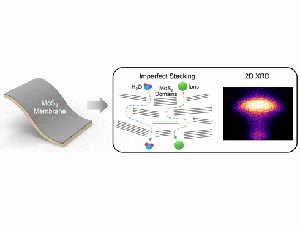Relating Selectivity and Separation Performance of Lamellar Two-Dimensional Molybdenum Disulfide (MoS2) Membranes to Nanosheet Stacking Behavior
 Environ. Sci. Technol. 2020, 54, 15, 9640–9651
Environ. Sci. Technol. 2020, 54, 15, 9640–9651
The abstract reads as follows: Increased demand for highly selective and energy-efficient separations processes has stimulated substantial interest in emerging two-dimensional (2D) nanomaterials as a potential platform for next-generation membranes. However, persistently poor separation performance continues to hinder the viability of many novel 2D-nanosheet membranes in desalination applications. In this study, we examine the role of the lamellar structure of 2D membranes on their performance. Using self-fabricated molybdenum disulfide (MoS2) membranes as a platform, we show that the separation layer of 2D nanosheet frameworks not only fails to demonstrate water-salt selectivity but also exhibits low rejection toward dye molecules. Moreover, the MoS2 membranes possess a molecular weight cutoff comparable to its underlying porous support, implying negligible selectivity of the MoS2 layer. By tuning the nanochannel size through intercalation with amphiphilic molecules and analyzing mass transport in the lamellar structure using Monte Carlo simulations, we reveal that small imperfections in the stacking of MoS2 nanosheets result in the formation of catastrophic microporous defects. These defects lead to a precipitous reduction in the selectivity of the lamellar structure by negating the interlayer sieving mechanism that prevents the passage of large penetrants. Notably, the imperfect stacking of nanosheets in the MoS2 membrane was further verified using 2D X-ray diffraction measurements. We conclude that developing a well-controlled fabrication process, in which the lamellar structure can be carefully tuned, is critical to achieving defect-free and highly selective 2D desalination membranes.
This work was supported by the Center for Enhanced Nanofluidic Transport (CENT), an Energy Frontier Research Center funded by the US Department of Energy, Office of Science, Basic Energy Sciences under award no. DESC0019112. We also acknowledge the Graduate Research Fellowship awarded by NSF to C.L.R. Characterization facilities used in this work were supported by the Yale Institute for Nanoscience and Quantum Engineering (YINQE) and the Yale West Campus Materials Characterization Core. We also acknowledge relevant technical assistance received from Min Li, Camrynn L. Fausey, Xuechen Zhou, and Douglas M. Davenport.
https://pubs.acs.org/doi/abs/10.1021/acs.est.0c02364
